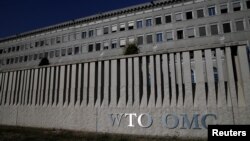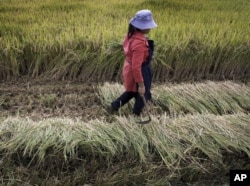The United States won a World Trade Organization ruling Thursday that China subsidized its wheat and rice producers too much in recent years.
The WTO in Geneva agreed with the U.S. position that Beijing paid its farmers excessive amounts for growing wheat, Indica rice and Japonica rice from 2012 to 2015, but said the dispute over a corn subsidy had already expired.
The ruling came in a U.S. complaint filed in 2016 during the final months of the last U.S. administration of former president Barack Obama.
The decision can be appealed, but current U.S. Trade Representative Robert Lighthizer praised the ruling.
"China's excessive support limits opportunities for U.S. farmers to export their world-class products to China," Lighthizer said in a statement. "We expect China to quickly come into compliance with its WTO obligations."
The U.S. claimed that China paid its farmers nearly $100 billion more than WTO rules allow, creating an incentive to grow more wheat and rice, thus undercutting global prices for the grains.
The ruling could have ramifications for India, which has calculated its price supports in a similar way as China.
The WTO decision comes amid intense trade talks between Washington and Beijing, with President Donald Trump expressing optimism a deal can be reached.
During a news conference in Hanoi after the abrupt end of his summit with North Korean leader Kim Jong Un, Trump said, "I think we have a very good chance. Their (economic growth) numbers are down, but I don't want that. I want (China) to do great. But we've been losing anywhere from $300 to $500 billion dollars a year with China for many, many years. And again, like other things, many presidents should have done this before me. And nobody did. So, we're doing it."
The most recent U.S. statistics show China last year had a $382 billion trade surplus in deals with the United States through November. Trump is trying to alter trade terms between the two countries to end what the United States, Japan and European countries contend are China’s unfair trade practices, including state intervention in markets, subsidies of some industries and theft of foreign technology.
But Lighthizer on Wednesday told a congressional panel in Washington, a new deal is not close to being completed.
"Much still needs to be done before an agreement can be reached," he said. “If we can complete this effort, and again I say if, and if we can reach a resolution on the issue of enforceability, we might have an agreement that enables us to turn the corner in our relationship with China.''
The United States and China, the world’s two biggest economies, have been negotiating for months on a new agreement, even as they have imposed hefty new tariffs on billions of dollars of each other’s exports.
Lighthizer said the countries’ negotiators, who have been meeting in Washington and Beijing, “are making real progress.”
Trump cited that progress on Sunday in postponing what would have been a sharp increase in U.S. duties on $200 billion in Chinese imports that would have taken effect Friday.
China has offered to increase its purchase of American farm products and energy as part of a new trade pact.






